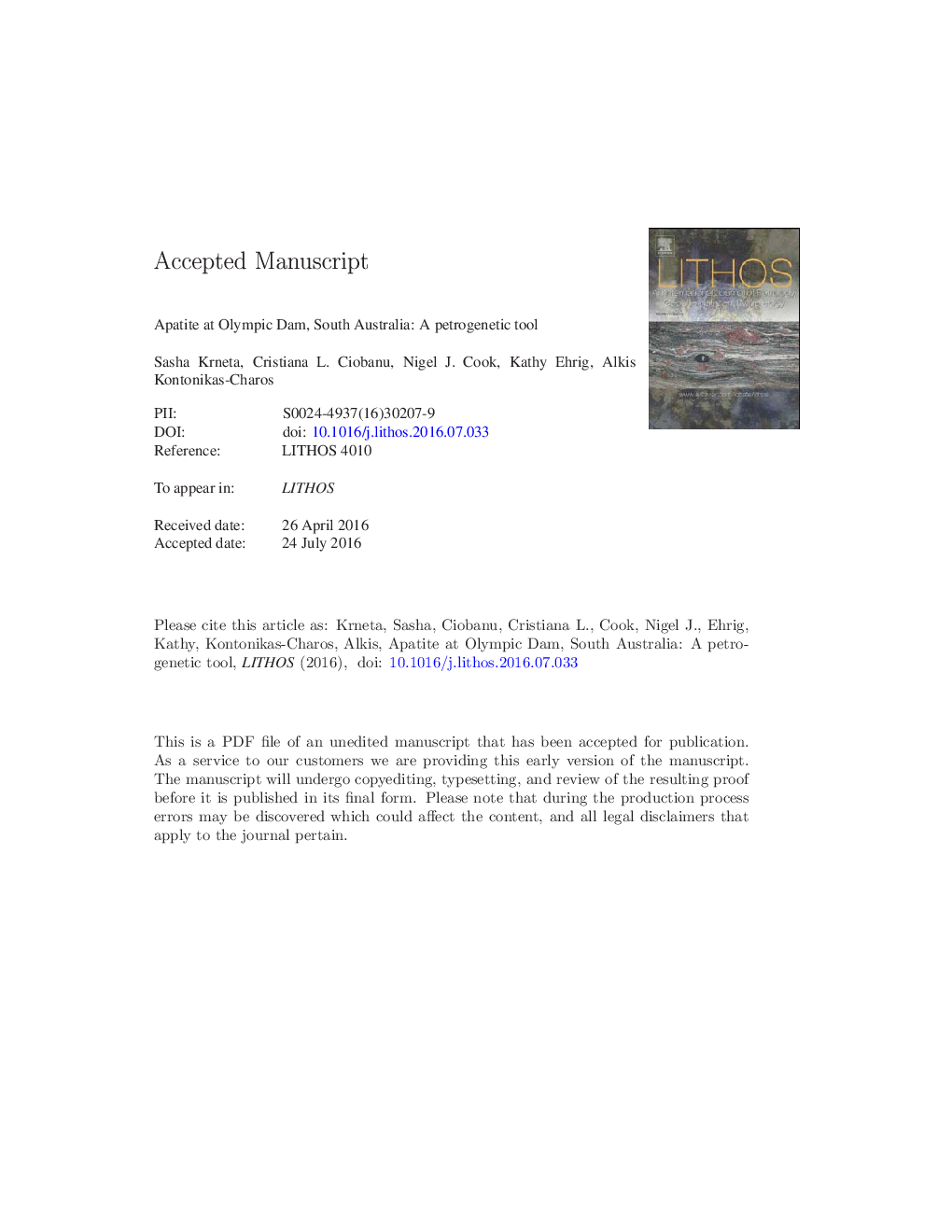| کد مقاله | کد نشریه | سال انتشار | مقاله انگلیسی | نسخه تمام متن |
|---|---|---|---|---|
| 6440510 | 1638642 | 2016 | 49 صفحه PDF | دانلود رایگان |
عنوان انگلیسی مقاله ISI
Apatite at Olympic Dam, South Australia: A petrogenetic tool
ترجمه فارسی عنوان
آلفات در سد المپیک، جنوب استرالیا: ابزار پتروژنیک
دانلود مقاله + سفارش ترجمه
دانلود مقاله ISI انگلیسی
رایگان برای ایرانیان
کلمات کلیدی
فلوراپاتیت، المپیک سد، ترکیب شیمیایی، مایعات هیدروترمال، منطقه بندی مقیاس دانه ای،
موضوعات مرتبط
مهندسی و علوم پایه
علوم زمین و سیارات
ژئوشیمی و پترولوژی
چکیده انگلیسی
The > 10,000 million tonne Olympic Dam Cu-Au-U-Ag deposit, (eastern Gawler Craton, South Australia) is one of the largest orebodies in the World. The deposit is hosted within the Olympic Dam Breccia Complex, placed at the centre of, and resulting from multiple brecciation and Fe-metasomatism of the Roxby Downs Granite (RDG). The latter is part of a larger batholith emplaced at ~ 1.6 Ga. Apatite petrography and chemistry were studied in non-mineralised RDG and coeval granitoids and dolerites, as well as in mineralised RDG from deep (> 2 km) and distal (2.7 km to NE) locations. In both latter cases, although the mineralisation corresponds to the same, early chalcopyrite-pyrite-magnetite ± hematite stage identified in the outer and deeper zones of the deposit itself, the character of granite alteration differs: sericite-chlorite alteration with all feldspar replaced in the deep location; and red-stained K-feldspar on top of prevailing albitization in the distal location. Close-to end-member fluorapatite is a key accessory mineral in all igneous rocks and a common product of early hydrothermal alteration within mineralised granite. Variations in habit, morphology and textures correlate with chemical trends expressed as evolving Cl/F ratios, and concentrations of REE + Y (hereafter REY), Sr, Mn, S, Si and Na. Magmatic apatite is unzoned in the dolerite but features core to REY-enriched rim zonation in the granitoids. Increases in Cl- and Sr-contents correlate with rock basicity. Calculation of Cl in the vapour phase relative to melt at the apatite saturation temperature for zoned apatite in the RDG shows higher values for grains with inclusion-rich cores associated with mafic enclaves, concordant with assimilation of exotic material during magma crystallisation. Hydrothermal alteration of magmatic apatite is most varied in the dolerite where interaction with fluids is expressed as subtle changes in Cl- versus F- and REY-enrichment, and most importantly, S-enrichment in grains adjacent to crosscutting, carbonate-sulphide-bearing veins. Highly acidic fluids, which not only corroded apatite but also quartz, led to recycling of REY via subsequent crystallisation of discrete REY-bearing species, notably monazite. Hydrothermal apatite often occurs as interstitial aggregates and displays a wider range of textures indicating variability in local growth conditions and/or sustained interaction with evolving hydrothermal fluids. Apatite from the deep mineralisation is richer in Cl whereas increases in ΣREY and S correlate with higher Si in both deep and distal cases. The co-correlation between Na and S in apatite from distal mineralisation ties apatite crystallisation to replacement of albite by sericite + chlorite. The textural and chemical variation of apatite relative to magmatic to hydrothermal transition suggests that the mineral represents a petrogenetic tool to gain insights into mineralising processes at Olympic Dam. Apatite evolution clearly played a key contributing role in the elevated REY-concentrations seen at Olympic Dam. The marked differences in apatite chemistry between mineralised and non-mineralised lithologies show promise for potential application as a tool in mineral exploration, in which apatite chemistry represents a means for outlining spatial position within an alteration envelope, or identifying if a particular alteration system is barren or fertile with respect to Cu-Au mineralisation.
ناشر
Database: Elsevier - ScienceDirect (ساینس دایرکت)
Journal: Lithos - Volume 262, 1 October 2016, Pages 470-485
Journal: Lithos - Volume 262, 1 October 2016, Pages 470-485
نویسندگان
Sasha Krneta, Cristiana L. Ciobanu, Nigel J. Cook, Kathy Ehrig, Alkis Kontonikas-Charos,
